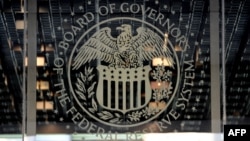The U.S. Federal Reserve has raised its interest rates for the first time in seven years. As a result, the U.S. dollar is strengthening, with a mixture of good and bad effects on other countries' economies.
The central bank's rate hike December 16 puts an end to a long period during which it kept U.S. interest rates within a range of 0 to 0.25 percent. That was to combat recession by making it very inexpensive for American businesses and consumers to borrow money, thus spurring economic growth.
Now, the Fed has raised the rate to a range of 0.25 to 0.50 percent. That is a signal that it sees the U.S. economy as healthy again and this tighter monetary policy, which makes it more expensive to borrow money, is aimed at keeping consumer borrowing below levels that could fuel inflation.
Here are four ways the U.S. bank's action directly affects people elsewhere in the world:
1. Stronger U.S. Dollar
The interest-rate hike does not only mean banks charge more interest for loans. It also means that U.S. banks will pay higher interest to those who lend them money; for example, investors. It means, too, that U.S. government bonds will pay higher interest rates to those who buy them.
That chance to earn more interest is likely to attract foreign investors to U.S. financial markets. And as the investors compete for the dollars they need to participate, the value of the currency rises.
The dollar made modest gains against the euro and the yen following the Fed's announcement, as the move was widely expected. However, more rate hikes are expected in the future, adding pressure for the dollar to keep moving upward.
A stronger dollar will be bad news for countries that have high existing levels of debt denominated in the U.S. currency. They will have to pay more of their own currency to acquire the dollars they need to make their debt repayments, putting a strain on their treasuries. At the same time, the stronger dollars means higher borrowing costs for countries that want to take new loans in dollars to finance new projects.
Just how quickly the Fed plans to raise the interest rate further is unknown. But many analysts say that the modest step made on December 16 signals a slow pace.
"Not only was the rise itself relatively small in scale, but the Fed tried to stress that the rise in interest rates over the coming years will be relatively gradual, suggesting that we are not going to see an aggressive tightening and we are not going to see a sharp rise in borrowing costs," says William Jackson, an emerging-markets specialist at London-based Capital Economics.
Still, any strengthening of the dollar is particularly alarming for commodity-exporting countries. Those countries are already facing economic difficulties from a global drop in commodities ranging from oil to metals to foodstuffs due to oversupply on world markets. Now they must pay more for dollars even as their earnings from their own exports are down.
2. Less Foreign Capital?
Emerging economies need outside investment to grow. But as the interest-rate hike now tempts investors to look toward America, it could mean less investment capital comes to other financial markets, including those in emerging countries.
That will be particularly true for emerging countries where investments are regarded as risky, either for political or economic reasons. Again, commodity-producing countries are particularly vulnerable as global commodity prices remain highly unpredictable due to oversupplies and uncertainties over when global demand for them might grow.
3. Higher Import Prices
As the dollar grows stronger, consumers will have to pay more in their own currency for imported goods and for domestic products that use imported materials.
Again, some of the countries most likely to be adversely affected are those which have based their export economies on commodities. Many commodity exporters, encouraged by rising commodity prices in earlier decades when global demand for oil and metals was high, concentrated so heavily on expanding their commodity production that they developed few other sectors, such as manufacturing. That makes those countries highly import-dependent.
4. Some Good News
However, while the stronger dollar created by the U.S. rate hike poses challenges for other economies, it also offers some opportunities.
That is because U.S. exports would now become more expensive to buy than similar goods produced by other countries whose currencies are weaker. Manufacturing countries in Europe and Asia are obvious beneficiaries but so, too, may be individual companies in many parts of the world who hope to win greater market share for their products against U.S.-based competitors.
Equally importantly, the ongoing recovery of the U.S. economy is good news for any company that exports to it and has suffered years of low sales due to the past recession.
"If the Fed continues to raise interest rates, it will be a reflection of the fact that the strength of the U.S. economy warrants tighter monetary policy and that, in itself, is a good thing for the world," says Jackson. "It means U.S. demand is strengthening, so in emerging markets we may see some rise in external demands [for their export products]."











